PinotFile: 11.35 December 8, 2018
|
On The Russian River Valley Pinot TrailIt has become a family tradition to celebrate each Thanksgiving in the Russian River Valley. Being from Southern California, our family is exposed to little change of seasons. Most days the sun is out, rain is a rarity, and the evergreens that dominate the landscape never change color. The Russian River Valley in November is a glorious refuge of heaven on earth. It is a time when wine tourists rarely visit, making the region’s roads less traveled and the area’s wineries easily approachable. The fields of vines are colored rust with the dying leaves of spent vines that are hunkering down for the winter and the remaining vine leaves offer a chorus of psithurism. There is a nip in the air, frost in the morning, billowy clouds in the sky, and welcome rain. Winemakers have caught their breath after a hectic harvest and are relieved to have barrels of Pinot Noir tucked away for the winter.
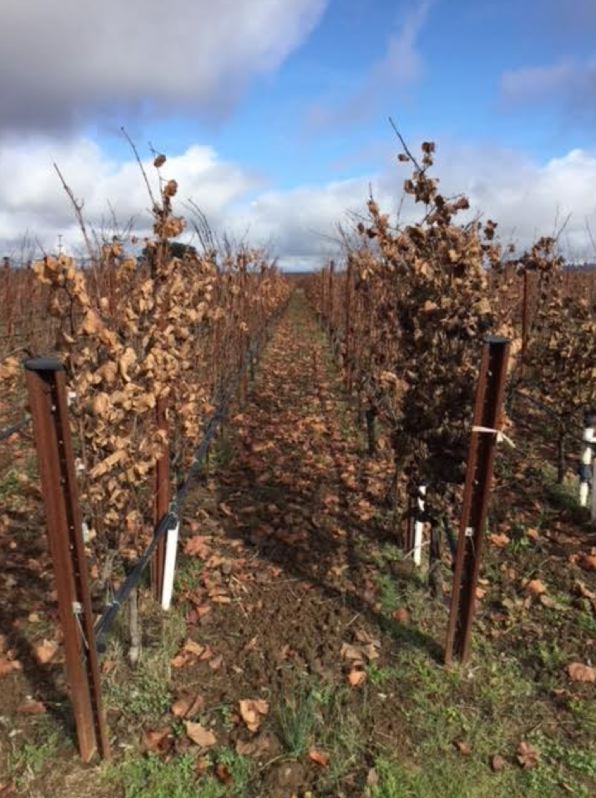 My wife, Patti, and two sons, Garrick and Dane, gathered for a Thanksgiving feast in the Russian River Valley. The centerpiece was a smoked turkey from Sebastopol’s WillieBird, a legendary purveyor of turkeys in the Russian River Valley.
 The wine I choose was a special magnum bottling honoring the 30th Anniversary of the iconic Russian River Valley Williams Selyem winery - the 2010 Williams Selyem Burt Williams Morning Dew Ranch Anderson Valley Pinot Noir. Needless to say, this was an exceptional wine.
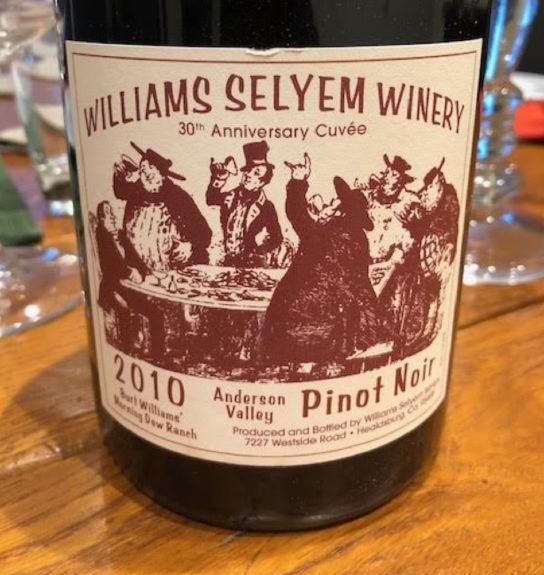 I took the opportunity to hit the Pinot Trail and renew old friendships and acquire new acquaintances. The following pages summarize some visits with Russian River Valley producers including Paul and Kathryn Sloan, proprietors of Small Vines, Kent Humphrey, proprietor of Eric Kent Wines, Pete Soergel, winemaker at Lynmar Estate, Theresa Heredia, winemaker at Gary Farrell Winery, Denise Selyem, proprietor and winemaker at WesMar, Robin Jackson, Director of Operations at Benovia Winery, and Trini Amador III, proprietor of Gracianna Winery. At my last stop on the trail, a magnificent rainbow appeared.
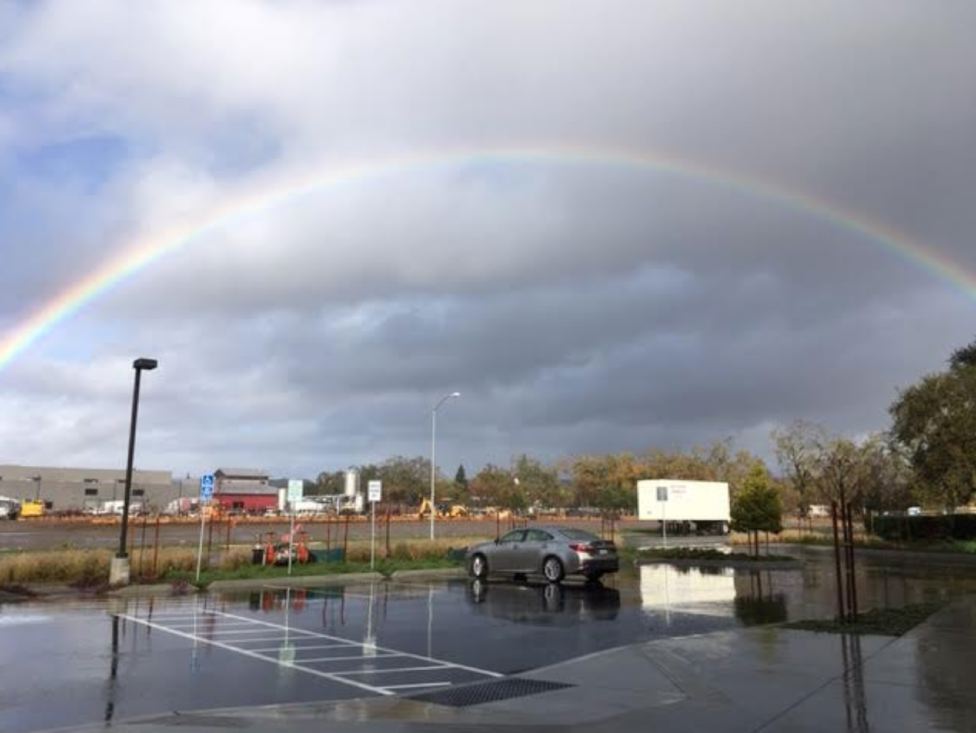 Bread is my favorite among the many artisan foods that are famous in Sonoma County. After Pinot Noir, bread is my paramour and I will seek it out with devotion whenever I am on the Pinot Trail. Sonoma County is the epicenter of artisan bread production in California and there are multiple bakeries offering superb baguettes, sourdough loaves, levain white, seeded white, ciabatta, and Pain d’epi loaves.
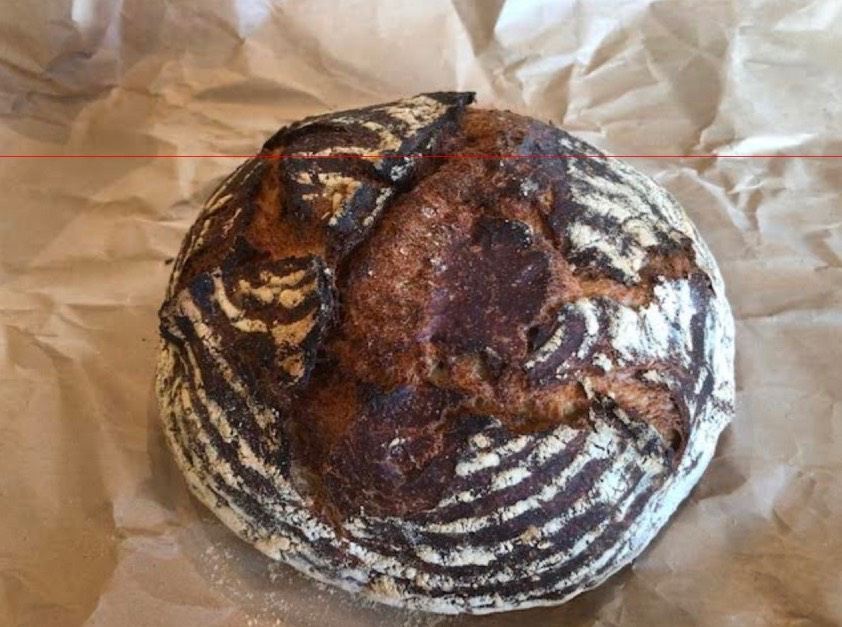 Bakeries to seek out for their breads when visiting Sonoma County include Red Bird Bakery in Santa Rosa, Village Bakery in Santa Rosa and Sebastopol, Goguette Bread in Santa Rosa, Downtown Bakery & Creamery in Healdsburg, Costeaux French Bakery in Healdsburg and Wild Flour in Freestone. There is nothing better than a slice from a great sourdough loaf spread with Straus’s Salted Butter or Clover’s Organic Unsalted Butter, both regional kinds of butter from Sonoma County favored by gourmands. Bread is actually enjoying a revitalization of interest in the US after 20 years of carb-slamming. Even among non-professional bakers, homemade, naturally fermented sourdough has become hip and sourdough bread baking hobbyists are proliferating.
Pinot Trail Diaries
Small Vines WinesPaul Sloan’s interest in Pinot Noir arose while he was working as a sommelier at John Ash & Co restaurant in Santa Rosa in 1995. It was an epiphanic experience with a rare Burgundy that ultimately changed his life. He went to work for the Dutton Ranch company to pursue more knowledge about winegrowing. In 1998, he convinced his spouse, Kathryn, that they should pursue winegrowing independently and they launched Small Vines Viticulture focusing on planting and farming high-density planted vineyards in the Russian River Valley and Sonoma Coast appellations. The next logical step was to produce their own wines and in 2005 they released their first Pinot Noir under the Small Vines label. The core idea behind Small Vines Wines is that Paul’s experience as a sommelier-led him to favor wines with reasonable alcohol levels and long age ability. He felt that high-density plantings were a way to achieve this goal. The winery’s tagline became, “The smaller the vine, the better the wine.” The Sloans have been developing Estate Vineyards since 1999 and have been committed to farming vine-by-vine with closely planted vines similar to European-styled vineyards. The vineyards are farmed organically and specifically groomed to produce fewer pounds per vine of superior quality fruit. Note the typical small cluster size compared to a quarter:
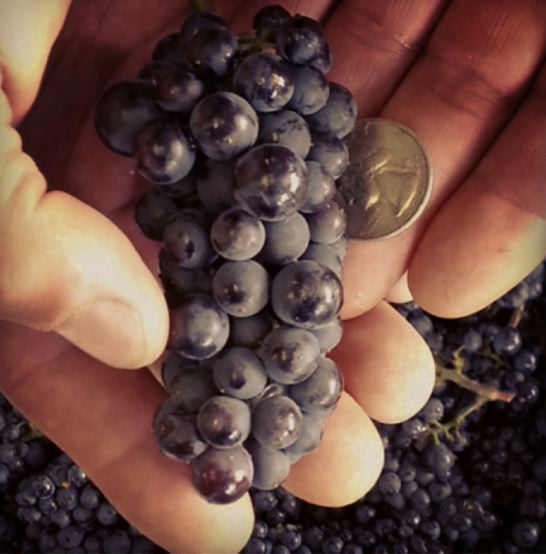 All Small Vines wines come from obsessively managed estate owned (TBH Vineyard surrounding the Sloan’s home and winery) or leased estate vineyards (MK Vineyard and Baranoff Vineyard). Typical plantings are dense at 2722-3630 vines per acre producing 1-2.5 pounds per vine. These physically smaller vines are considered to be ideally balanced with less fruit naturally than a larger vine. With the vines closer together, the fruit receives less solar radiation due to the proximity of the neighboring vine row resulting in better acid retention in the grapes. The goal is farming to obtain grapes that retain more natural acids and achieve ripeness at lower Brix levels resulting in wines with modest alcohol levels. You will notice that the Pinot Noir wines reviewed here have alcohol levels in the 13.2.-13.6 range. After spending time with Paul, it is obvious that he is in love with growing and vinifying Pinot Noir and Chardonnay. His enthusiasm is boundless, yet he proceeds with a carefully thought out agenda. He works both on the grower side as the owner of Small Vines Viticulture, Inc., and the producer side as winemaker for Small Vines wines. A relatively new winemaking facility on the estate property incorporates walls of a historic building once part of the Barlow family’s homestead and contains the latest winemaking technology. Veteran winemaker, Byron Kosuge, is the consulting winemaker. The Small Vines Pinot Noir wines are vinified with natural yeast fermentation after picking in the cold of the night. Varying amounts of whole cluster are used during fermentation. The wines are aged in 3-year air-dried French oak barrels (mainly Atelier and Siruge), about 25%-30% new for 14 months on the fine lees and then bottled unfined and unfiltered. Vineyard-designated bottlings only contain dry-farmed fruit. The Small Vines Chardonnays are typically harvested at 21.5º-22.0º Brix. Native yeast fermentations are carried out in mostly neutral French oak barrels. Secondary (malolactic) fermentation is allowed and the wines are aged 10-11 months in a combination of new and neutral French oak barrels. The wines are bottled unfined and unfiltered. The following wines were reviewed both at the winery with Paul and at home later under my usual controlled environment. These are superb wines with hallmarks of freshness and vibrancy attributed to uplifting natural acidity. The judicious use of whole cluster fermentation adds complexity. The wines can be obtained through the winery’s mailing list or the winery website at www.smallvines.com. 75% of sales are through the mailing list and wine club. Shipping in the U.S. is always complimentary. Magnums are available. All 2016 vintage wines have been released.
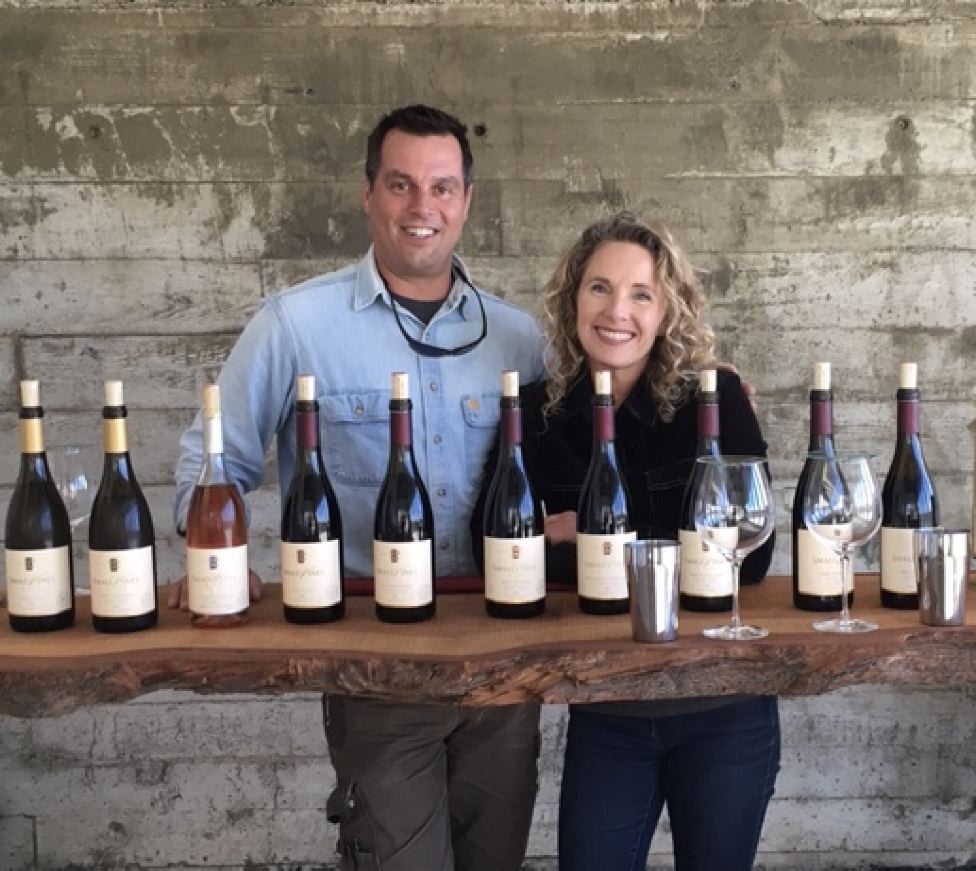
2016 Small Vines Sonoma Coast Pinot Noir 13.6% alc., pH 3.60, TA 0.58, 600 cases, $55. 100% estate grown and bottled with 40% of the grapes from TBH Vineyard. Includes irrigated vines and vines with smaller shoots. Clones include Calera, Pommard, Swan, 943, 459, 114, 115, 667 and 77. 35% whole cluster. Aged 12 months on fine lees in French oak barrels, 23.5% new. Bottled unfined. · Moderate garnet color in the glass. Well appointed nose with aromas of dark cherry, blue berry, spice and subtle oak toast. Mid weight plus core of dark red fruits framed by subtle oak and peach-skin tannins. Bright acidity, finishing with hearty fruit and a hint of citrus. Score: 90
2016 Small Vines Estate Cuvée Russian River Valley Pinot Noir 13.5% alc., pH 3.68, TA 0.53, 383 cases, $65. The proprietor’s blend from Baranoff, Fassler, MK and TBH vineyards, all organically farmed by Small Vines Viticulture, Inc. All dry-farmed fruit. Pommard, “828,” 943, 459, and Dijon 113, 114, 115, 667, 777 and 943. 100% free run. 50% whole cluster. Aged 17 months on fine lees in French oak barrels, 20% new. Bottled unfined and unfiltered. · Moderately dark garnet color in the glass. A melange of red and blue fruits with a note of nutty nougat and pine show up on the inviting nose and the mid weight plus styled palate. A grand attack of black cherry goodness continues through a long finish glamorized with a haunting black cherry fragrance. The wine is well-structured and energized with good acidity predicting age ability. Score: 92
2016 Small Vines MK Vineyard Sonoma Coast Pinot Noir 12.8%, pH 3.62, TA 0.56, RS 0.1 g/L, 44 cases, $82 (sold out). Vineyard planted by Small vines Viticulture, Inc in 1999 on an east-facing ridge above Occidental at 800 feet elevation, 10.5 miles from the coast. Harvest Brix 22.5º. 5-day cold soak, 45% whole cluster native yeast fermentation. All free run juice. Aged 15 months on fine lees in French oak barrels, 33% new. Bottled unfined and unfiltered. · Moderately dark garnet color in the glass. Complex aromatic profile including underbrush, cherry, dark rose petal, and gingerbread spices. The dark cherry fruit is accented with a savory herbal, floral and forestry background theme. Silky in the mouth, with redeeming acidity. Score: 93
2016 Small Vines Baranoff Vineyard Sonoma Coast Pinot Noir 13.2% alc., pH 3.61, TA 0.60, RS 0.2 g/L, 70 cases, $82. Available to mailing list members by allocation only. Grapes grown in lean, iron-rich soil. 3-acre vineyard planted in 2001 by Small Vines Viticulture, Inc., and organically farmed. Clones include Calera, Swan, 115, 459, 667 and 777. Harvest Brix 21.5º-23.5º 5-day cold soak, 65% whole cluster native yeast fermentation. Aged 15 months on fine lees in 100% neutral French oak barrels. Bottled unfined and unfiltered. · Moderately dark garnet color in the glass. Aromas of earthy flora, cherry, raspberry, dark berries, rose petal and subtle oak. Light to mid weight in style and black cherry driven on the palate, with an underpinning of savory herbs. A bit rustic, yet charming, with a silken mouthfeel, good energy and tension, deft oak management, and a pleasing finish. Score: 93
TBH Vineyard wines are only available to mailing list members by allocation. The vineyard was planted in 2009 at the Barlow Homestead in Sebastopol on a cool and windy ridge with heavy coastal influences. 3630 vines per acre, and typically .98 lbs per vine. Clones include Calera, Swan, Pommard, 943 and 459. Some distributors still have the 2014 and 2015 vintages and would be available in stores in some states.
2014 Small Vines TBH Vineyard Sonoma Coast Pinot Noir 13.2% alc., 109 cases, $82. · Moderate garnet color in the glass. Nicely perfumed with aromas of dark red cherry, plum, fragrant mulch and fertile earth that hold up over time in the glass. The lightest and most delicate of the three TBH vintages tasted here, yet has redeeming mid weight flavors of black cherry and purple berry with a bit of toasty oak in the background. Comforting in the mouth, with a round mouthfeel, and an invigorating liveliness. Score: 93
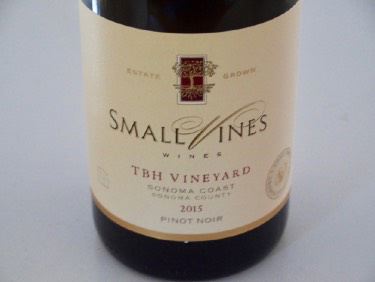 2015 Small Vines TBH Vineyard Sonoma Coast Pinot Noir 13.2% alc., 246 cases, $82. · Moderately dark garnet color in the glass. I was enamored with the nose that offered deep and expressive aromas of cherry, purple berry and exotic spices. A robust charge of well-ripened dark red cherry and berry fruits alerts the senses. The fruit seems to come in waves, immersing the mid palate and finish bold and long. A touch of spice and forest adds interest. Nicely composed with a healthy tannic backbone that blends in for accomplished harmony. This wine has an impressive arsenal of aromas and flavors. Score: 95
2016 Small Vines TBH Vineyard Sonoma Coast Pinot Noir 13.2% alc., pH 3.52, TA 0.59, RS 0.2 g/L, 295 cases, $82. Harvest Brix 20.8º-23.2º. Clones include Calera, Swan, Pommard, 943 and 459. Yields .98 lbs per vine.5-day cold soak, 60% whole cluster, native yeast fermentation. Aged 15 months on fine lees in French oak barrels, 24% new. 100% free run juice. Bottled unfined and unfiltered. · Moderately dark garnet color in the glass. Lovely aromas of black cherry, boysenberry, black plum, beef grilling rub and a nip of nutty oak arrive with aplomb over time in the glass. Mid weight plus in style, with flavors of cherry, blueberry and purple grape and a companion note of savory herbs. Noticeably juicy, with taut tannins that show up on the slightly astringent, but lip-smacking finish. Still young, achieving more brilliance and better integration of tannins when tasted several hours after opening. Score: 94
2016 Small Vines Sonoma Coast Chardonnay 14.1% alc., pH 3.24, TA 0.64, 625 cases, $55. 100% estate grown at TBH Vineyard and estate bottled. Hyde Wente and Kistler Mt Eden Wente selections planted in Goldridge sandy loam. Whole cluster pressed and barrel fermented with native yeast and native ML with minimal battonage. Aged 11 months on fine lees in French oak barrels, 14% new. Bottled unfined. · Moderate golden yellow color in the glass. Refreshing aromas of yellow apple, ripe grapefruit and nut oil. Sleek and polished in the mouth with flavors of lemon, pineapple, crisp apple and melon. The discreetly assertive acidity drives the refreshing nature of this wine, but the acidity is not imposing. Score: 91
2016 Small Vines TBH Vineyard Sonoma Coast Chardonnay 13.8% alc., pH 3.18, TA 0.72, RS 1.1 g/L, 297 cases, $72. 100% organically grown and estate bottled. The vineyard, planted in 2009, is exposed to heavy coastal influences. 3630 vines per acre planted in Goldridge sandy loam soil. Hyde Wente and Kistler Mt Eden Wente selections. Gently whole cluster pressed, barrel fermented with native yeast and native ML with minimal battonage. Aged 11 months on fine lees in French oak barrels, 8% new. Bottled unfined and unfiltered. · Moderate golden yellow color in the glass. This wine is clearly for connoisseurs. Aromas of green apple, citrus, white flower blossom, petrichor and nut oil. Discretely luscious in the mouth with vibrant flavors of citrus and green apple. With little new oak overlay, the fruit comes across as unadorned and pristine. The texture is pleasingly viscous and the lemonscented, saltine finish is unusually long. It is very easy to like this regal wine that possesses laser-like clarity. Score: 94
Eric Kent Wine Cellars
 I have followed the wines of proprietor and winemaker Kent Humphrey since the winery’s early beginnings in 2003 when the winery was launched with 375 cases. I have tasted practically every Pinot Noir Kent has produced since 2004, enamored by his winemaking skills and the colorful artwork that adorns every label. The label says “Eric Kent,” but there is no Eric Kent. Eric is Kent Humphrey’s middle name and Kent is his first name. Being humble, Kent just could not bear to choose a blatantly eponymous name for his winery. He also felt that people in a nice restaurant might be adverse to ask for a bottle of “Humphrey” Pinot Noir. So, he inverted his first and middle names and his “nom de vin” came to be. Kent grew up in California around a family table that enjoyed wine but his college path was in French at Cal Berkeley. He was awarded a Regent’s Fellow Scholarship in the PhD French program, but soon opted out of academia and pursued a career in advertising. He started his own agency and the company was highly successful, employing more than fifty people. However, the experience “sucked the joy out of life.” His only respite was wine that he collected and delighted in. He finally left the advertising world, encouraged by family and friends to seek a career in wine. Because he realized that many of the wines he most admired were made by people who had no formal training in wine, he decided against attending UC Davis for winemaking education. Instead, he sought hands-on experience. When he launched Eric Kent Wine Cellars in 2003, he chose to make Pinot Noir, Chardonnay and Syrah, since these were the varietals that gave him the most pleasure.
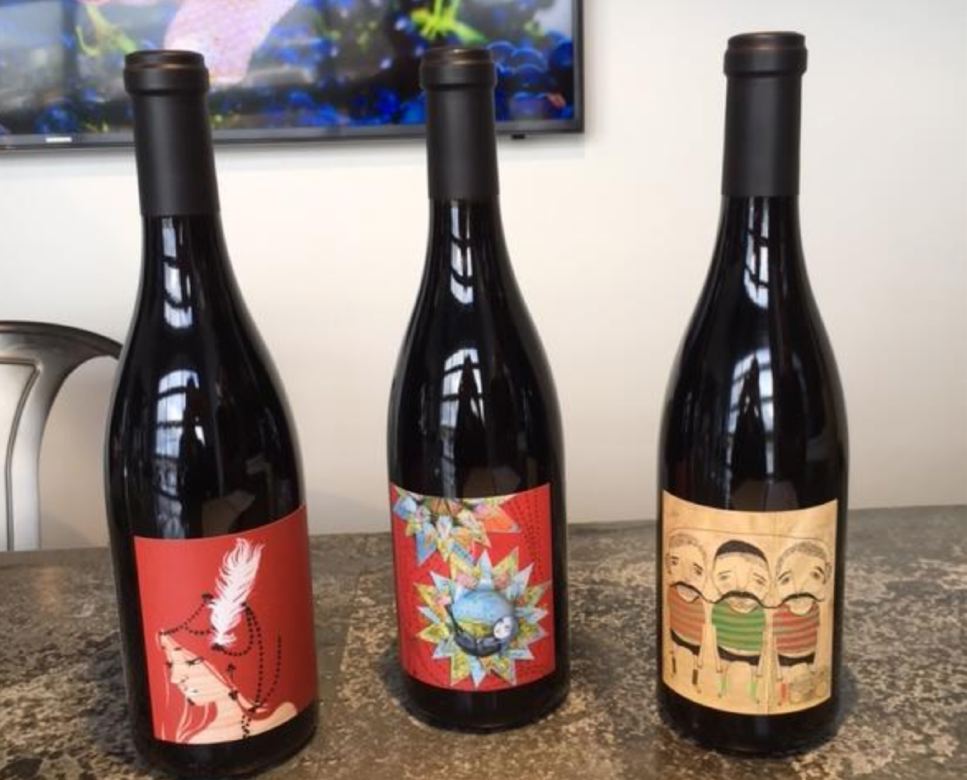 Kent and his spouse, Colleen, an accomplished artist and DJ, decided one day over a dinner of burgers and Zinfandel to showcase artists on their bottles. The result has been striking works of unique art on the front label of every Eric Kent wine. Each artist brings a unique vision that compliments the spirit behind the wines. As one wine retailer put it, “The wines speak for themselves and the labels add another dimension to the wine by creating a built-in discussion with every cork pulled.” Currently, the recurring annual wines display labels from the permanent collection of art, while limited bottles sport special one-of-a-kind art. Kent took on Hanna Hollingsworth as his co-winemaker beginning in 2011 and she works diligently in the background. Like Kent, she did not have intentions to be a winemaker and was trained at an early age as a classical pianist. She worked in the world of fine dining for years before spending her first harvest at Carlton Winemakers Studio in the Willamette Valley of Oregon. The two winemakers work together at the newly opened Grand Cru Custom Crush facility in Windsor. This is a state-of-the-art facility with the latest winemaking equipment, hosting eighteen wineries and providing individual rooms for smaller wineries to conduct tastings for consumers. You can schedule a tasting with Kent or Hanna through the website at www.erickentwines.com. Eric Kent wines are sold through an allocated mailing list.
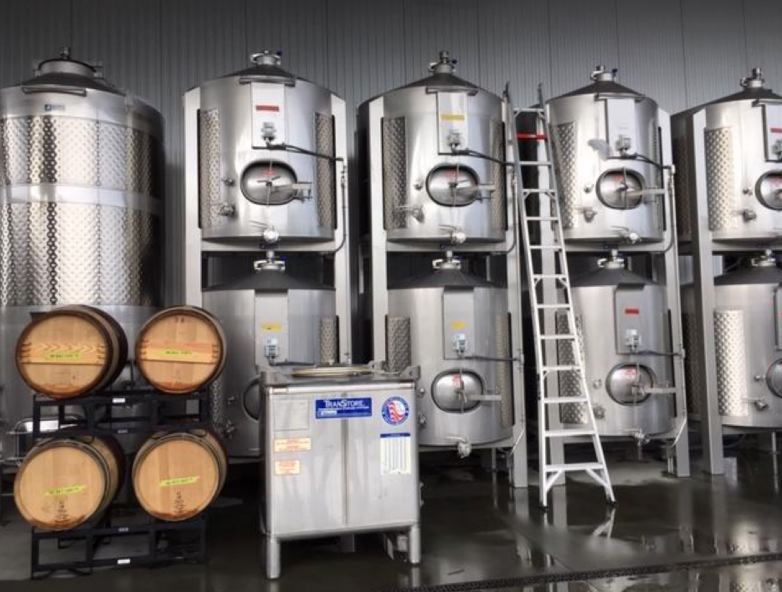
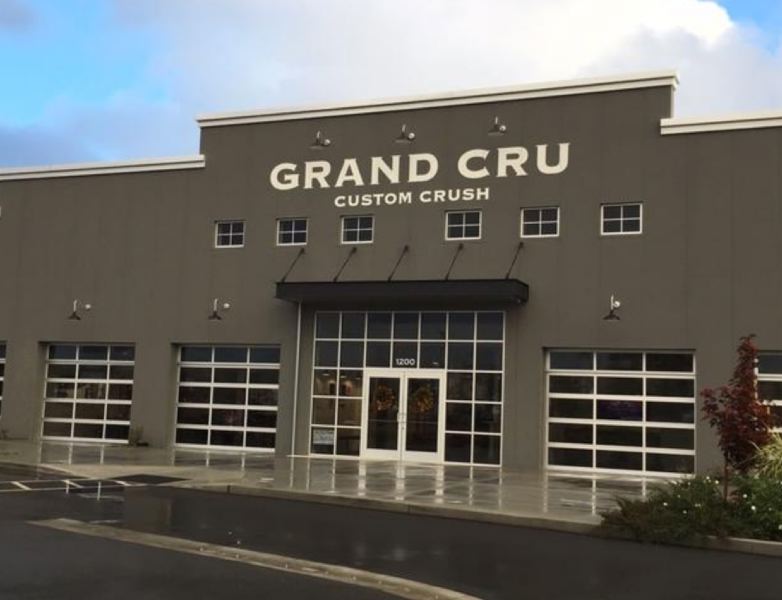
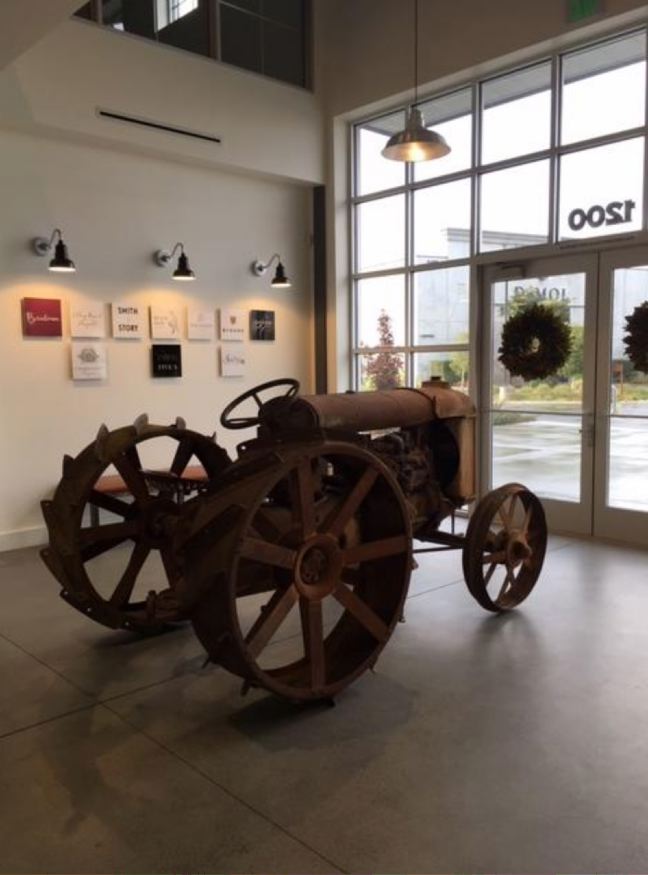 (Note: you can also taste the Pinot Noir wines of several producers prominently reviewed in the PinotFile including Black Kite Cellars, Bucher, Ernest Vineyards, and Sangiacomo. You can taste with a specific winery or experience a varied “Vintners’ Selection” that includes wines from select winemakers at the facility). Visit www.grandcrucustomcrush.com. The following wines represent 2018 spring releases (Small Town and Sascha Maria) and 2018 fall releases (Stiling)
2016 Eric Kent Small Town Sonoma Coast Pinot Noir 13.7% alc., pH 3.52, TA 0.65, 207 cases, $52. Three Amigos label by Kelly Puissegur. Sourced from western Petaluma Gap fruit including Grand Vent Vineyard (94%) and Cleary Ranch (6%). Clones are Pommard, 667, 113, 115 and 943. · Moderate garnet color in the glass. Engaging perfume of black cherry, spice and dried herbs. Succulent blueberry and purple grape flavors with a subtle savory note of herbs and tobacco. Elegant in style, with felty tannins and bright acidity, finishing with some persistence. Score: 92
2016 Eric Kent Stiling Vineyard Russian River Valley Pinot Noir 14.6% alc., pH 3.70, TA 0.62, 400 cases, $52. Artist Eliza Frye. Kent has worked with this vineyard, now owned and farmed by the Dehlinger family, for several years. · Moderate garnet color in the glass. Intensely fruity nose offering aromas of purple and black berry fruits with a compliment of spice. Hearty, in a mid weight plus, fruit-driven style, with flavors of boysenberry and blackberry with an undertone of dark chocolate and toast. The wine finishes with a blissful basket of dark and fragrant fruit. Score: 92
2016 Eric Kent Sascha Maria Sonoma Coast Pinot Noir 14.7% alc., pH 3.60, TA 0.63, 247 cases, $52. Art by Valerie Savarie. This bottling is named after Kent’s daughter and is sourced from Sangiacomo Roberts Road Vineyard (95%) and Grand Vent Vineyard (5%). Primary clones are 777 and Swan with a small amount of Pommard and 667. · Moderate garnet color in the glass. Rapturous nose offering scents of black cherry, black raspberry and exotic spices. Vivid, fresh purple and black fruit flavors filled out with a compliment of oak. The burliest and fruitiest wine of the three tasted here, but not jammy. Excellent harmony with pleasing length on the finish. Score: 93
Gracianna WineryThe Amador family pays tribute in naming their winery to the family’s great-great-grandmother, Gracianna Lasaga, a French Basque who emigrated to the United States after World War II and with her husband raised large herds of sheep in Santa Barbara County. The entire concept behind the name and label is being grateful for what the Amador family has. The picture of the gift on the bottle was painted by Trini Amador IV’s paternal grandfather. The painting symbolizes having a gift every day, being grateful for what they have, and putting it into a bottle. A sculpture of the gift is on the estate grounds.
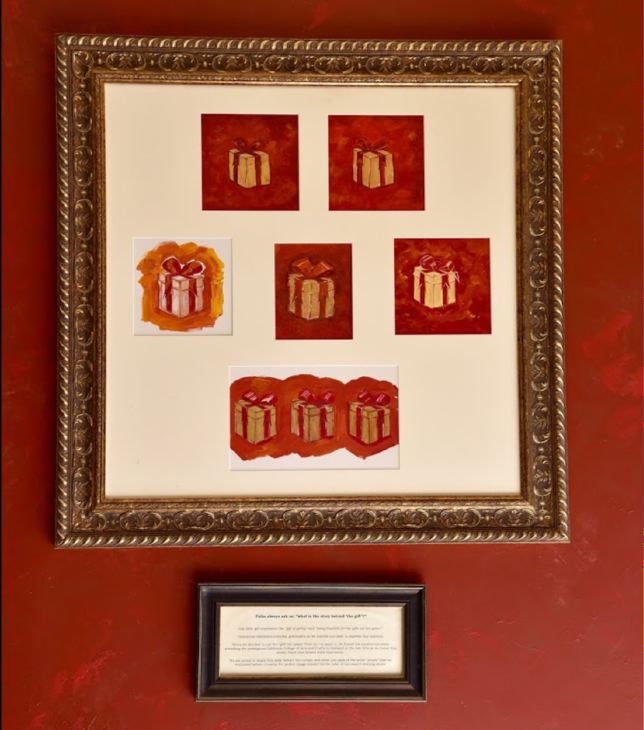 The winery, located in the Middle Reach of the Russian River Valley situated on Westside Road, the “Rodeo Drive of Pinot Noir,” was founded in 2005 by Trini Amador III and Lisi Amador, along with their son, Jose Trinidad (Trini) Amador IV. Trini IV is a Sonoma County native who became interested in winemaking as a teenager, crafting wine at the home garage at age 15, interned at Williams Selyem with winemaker Bob Cabral, and returned to the Russian River Valley after college at Oregon State University. He later became a vineyard manager for a large ranch in the Napa Valley. The first release of Pinot Noir (60 cases) and Zinfandel (50 cases) was in 2007. Since then, the winery has won medals at every notable wine competition they have entered. Winemaking is a family affair at Vinifi, a custom crush facility in Santa Rosa. The Pinot Noir wines since 2015, in particular, have shown considerable refinement and balance. The winery’s Healdsburg tasting room, opened in 2012, is located on Westside Road among many prestigious neighbors such as Arista, MacRostie, Rochioli and Williams Selyem, and is open daily by appointment except Wednesday from April through December (but wine is sold year-round). A Private Estate Tour and Tasting with the owners is available on weekends. Gracianna is recognized by the American hospitality industry as a top performer and a recipient of the Trip/Advisor Certificate of Excellence. The tasting room receives over 5,000 visitors a year. The Amadors want to bring everyday gratitudes to life through an intimate experience in their tasting room. The tasting room is pictured below. Adjacent to the tasting room is a magnificent home, a John Pfleugar design inspired by the architecture of the Renaissance and the Tuscany region of Italy.
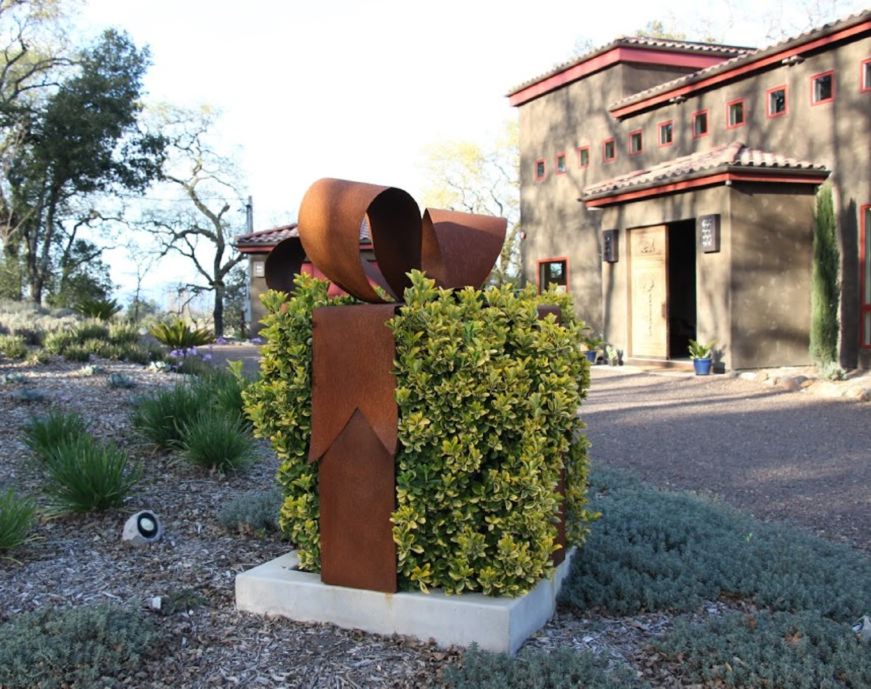 The winery’s estate vineyard, Mercedes Riverblock, named after a family matriarch, grandmother Mercedes Sordia, is 1.17 acres planted to Dijon clone 115 in 2009. The vineyard borders the Russian River Valley in the space between the riverbank and Westside Road. The first Gracianna Mercedes Riverblock Estate Pinot Noir was released from the 2013 vintage. Production is about 2,000 cases annually of primarily Pinot Noir, Chardonnay and Zinfandel. All wine is sold direct to consumer. Visit the website at www.gracianna.com. The following wines were reviewed in the home of Trini Amador III. The 2016 Estate and 2017 Reserve were re-tasted under controlled circumstances at my home later. The Pinot Noir wines are vinified with primarily 2-3-year-old French oak barrels with little to no new oak. The wines show good balance, even those with higher ABV.
2014 Gracianna Bacigalupi Vineyard Russian River Valley Pinot Noir 15.2% alc., 437 cases, $54. Released April 2016. Aged 11 months in French oak barrels. Bottled unfined and unfiltered. · Both savory and fruity in a red-fruited style with a compliment of spice and a tangy, red cherry driven finish. Score: 90
2015 Gracianna Bacigalupi Vineyard Russian River Valley Pinot Noir 14.8% alc., 269 cases, $54. Release TBD. · A generous concentration of dark red and black fruits complimented by a savory thread that is typical of Pinot Noir from Bacigalupi Vineyard. Score: 92
2016 Gracianna Bacigalupi Vineyard Russian River Valley Pinot Noir 15.6% alc.. Release TBD. Very ripe fruited, even a tad roasted fruit character in a mid weight plus style with taut tannins, integrated alcohol, and some finishing length. No savory component in this virile, ripe fruit dominated wine. Score: 89
2015 Gracianna Westside Reserve Russian River Valley Pinot Noir 14.8% alc., 144 cases, $76. Released July 2017. 10th Anniversary bottling. Gold medal at the Sonoma County Harvest Fair. A blend of clones 667, 777 and Pommard from Bacigalupi Vineyard. · Beautifully composed in a middleweight style with luscious red fruit that is nicely spiced. The fine-grain tannins make for easy consumption and this stellar wine is beautifully balanced. Note: this wine was previously reviewed in 2017 with a consistent score. Score: 94
2017 Gracianna Westside Reserve Russian River Valley Pinot Noir 14.8% alc., 74 cases, $76. Release TBD in 2019. · Moderately light garnet color in the glass. Aromas of dark cherry and ripe strawberry fill the glass. Surprisingly forward for a 2017 release, displaying a deep spiced cherry flavored core filled out with a bit of toasty oak in the background. Soothing in texture and easy to like, yet needs more time to fully integrate the components. Score: 91-93
2015 Gracianna Mercedes Riverblock Estate Russian River Valley Pinot Noir 14.6% alc., 154 cases, $68. Released April 2017. clone 115. Aged 11 months in French oak barrels. Bottled unfined and unfiltered. · A robust wine with attacking red cherry fruit, expansive in the mouth with inviting accents of spice, savory herbs and a deft hint of oak. Nicely composed. Score: 92
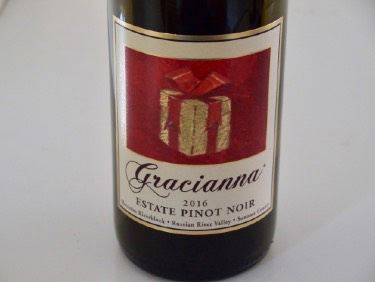 2016 Gracianna Mercedes Riverblock Estate Russian River Valley Pinot Noir 13.5% alc., 232 cases, $54. Release TBD. · Moderate garnet color in the glass. Perfumed with aromas of black cherry, cola, pomegranate, toast and a subtle peppery note. Welcome juiciness and silky in texture, with buried tannins, offering lavish black cherry fruit flavor and an accent of baking spice and the slightest toasty oak. The wine gathered interest and expression when tasted several hours after opening and the following day from an open and re-corked bottle. Score: 94
Lynmar EstateThis winery was featured in the November 2, 2018 issue of the PinotFile: www.princeofpinot.com/article/2112/. The excellent 2016 vintage Pinot Noirs and Chardonnays were reviewed. The winemaker since 2017 has been Pete Soergel. He has an agricultural background since he grew up on an apple farm and studied horticulture in college. Pete has worked at Lynmar Estate as both an assistant and associate winemaker since 2011 so he is very familiar with the estate vineyards and other sources of grapes for Lynmar Wines. Prior to his time at Lynmar Estate, he spent three years working at Kosta Browne alongside winemaker Shane Finley who continues on at Lynmar Estate as a consultant. I met Pete on a rainy day to taste a number of 2017 Pinot Noirs from barrel in the winery’s caves. This was the first vintage that Pete vinified at Lynmar Estate as the head winemaker. Uneven weather during the 2017 growing season included heavy winter rains, flooding of a number of Russian River Valley vineyards in low-lying sites, a heat spike in September around harvest and rain during the harvest period. Bud break was early in the spring and the late summer heat led to a very early harvest. In addition, vintners in the Russian River Valley had to deal with early October firestorms that made access to some wineries challenging if not impossible while wines were undergoing processing or in barrel. Most regional Pinot Noir was picked before the fires which were some consolation. Fortunately, Lynmar Estate’s winery and estate vineyards were in locations not involved in the fires. Pete and I tasted from multiple barrels in conjunction with a geeky discussion of the wines that I won’t bore you with here. Pete has a variety of heritage selections including Swan, Mt Eden and Calera to work with, as well as all the commonly grown Dijon clones. The variety of clones and selections are planted in multiple blocks and consist of both young and old vines in the estate Quail Hill Vineyard that is adjacent to the winery. The complexity of the Quail Hill Vineyard can be appreciated by viewing the block mapping of the vineyard below.
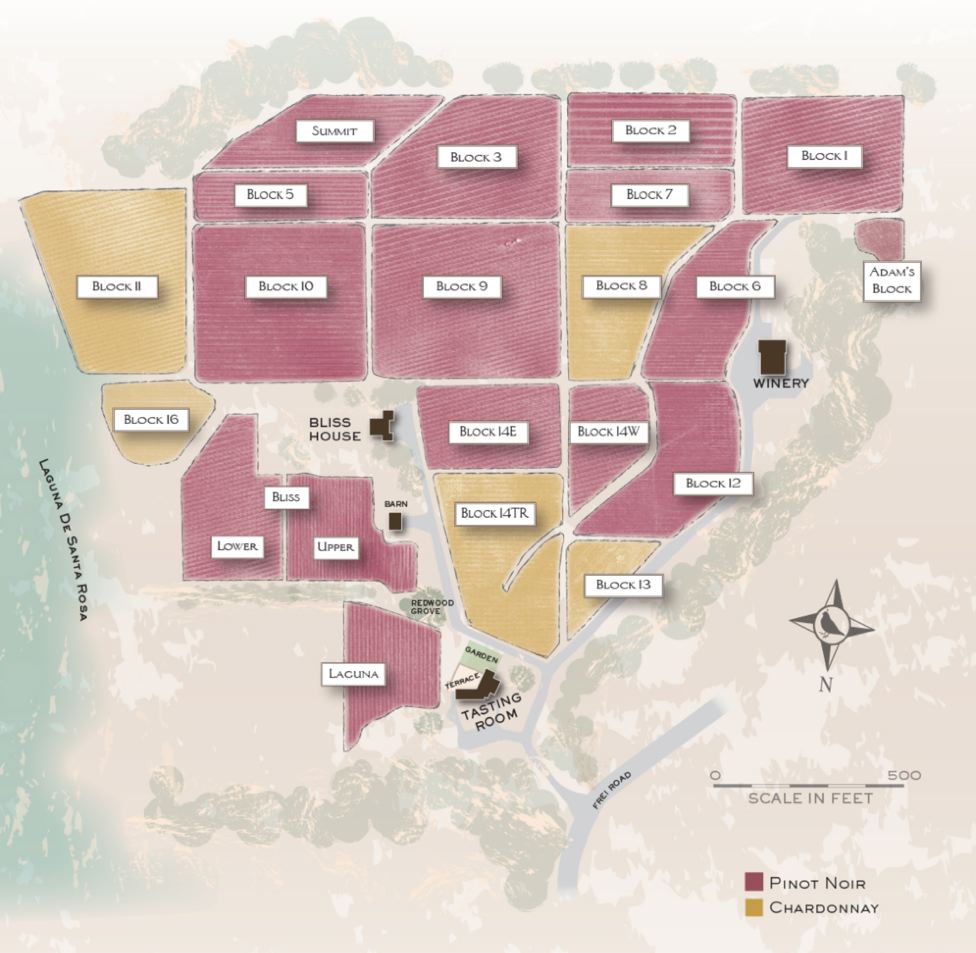 One of Pete’s challenges is matching cooperage to the myriad sites, blocks, and variable vine ages of lots of wine in the Lynmar cellar from the three estate vineyards. How he manages this complex puzzle is a tribute to his skill and experience. I found both new and older plantings of Swan selections to be the most glorious barrel samples in the cellar. The vineyard team, led by Jason Saling, manages 70 individual vineyard blocks and 19 clones that Pete transforms into over 90 separate lots of wine in the cellar. Because of the symbiotic relationship between Pete and Jason, Pete is able to understand intimate details of the estate vineyards and has the luxury to dictate specific pick times at harvest. The Lynmar Estate is made up of three currently producing sites: Quail Hill Vineyard surrounding the winery and hospitality center (45 acres, 17 distinct blocks with 14 Pinot Noir and 4 Chardonnay clones/selections, originally planted in 1974 with replanting beginning in 1996), Susanna’s Vineyard located in the Green Valley of Russian River Valley AVA about two miles from Quail Hill (10 acres of Pinot Noir and 10 acres of Chardonnay) planted in 2006, and Adam’s Vineyard situated above the fog line on a hillside in Forestville (9 acres planted in 2013 to Pinot Noir and Chardonnay). A fourth estate vineyard is being developed in the South Sebastopol Hills off Hwy 116 just north of Cotati. Still to be named, this will be the coolest estate vineyard. A variety of clones will be planted there in the Cotati sandy loam soil (similar to Goldridge soil). Grapes are also sourced from local vineyards such as Kanzler and Sweeney. Pete has a state-of-the-art gravity flow winery and a 9000-square-foot cave for barrel ageing at his disposal. His vinification regimen includes the use of moderate amounts of whole cluster during primary fermentation. The Pinot Noirs are aged between 11 and 15 months in 100% French oak barrels, commonly between 46% and 64% new. He produces at least twenty different Pinot Noir and Chardonnay wines including Pinnacle Tier blends, Block Designates, Vineyard Designates and Proprietary Blends. The winemaking team (Pete is in the center):
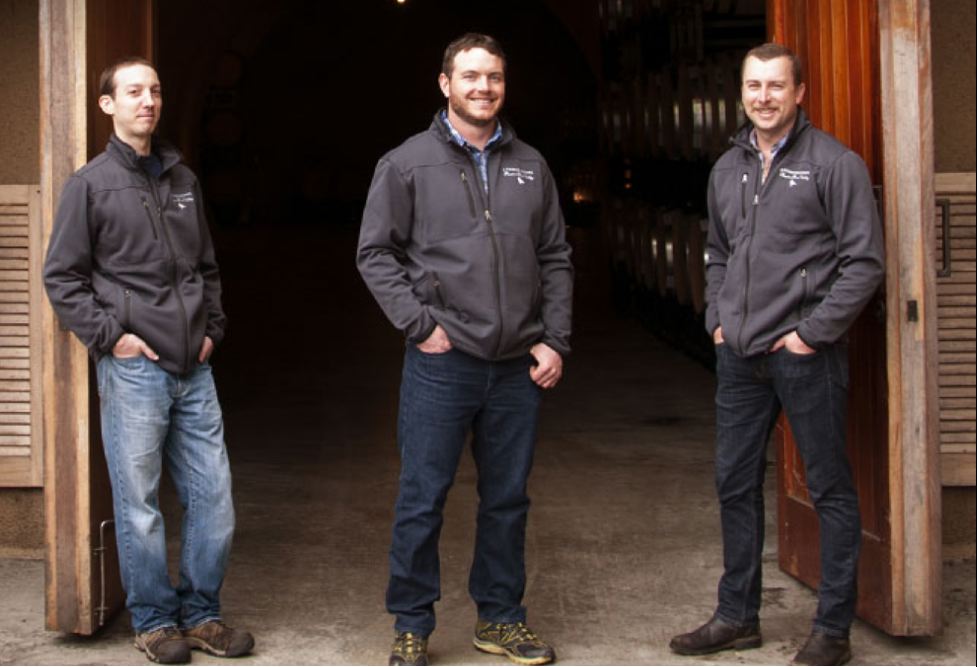 As I said in my recent article about Lynmar Estate wines, the Pinot Noirs and Chardonnays are standard bearers for the region. Wine tasting in the bucolic hospitality center at Lynmar Estate is available by appointment. Several tasting options are offered as well as wine and food experiences. The wines are available on the website. Members of the mailing list and Advocates Club enjoying special pricing and privileges. Visit www.lynmarestate.com.
85th Year Anniversary of Prohibition Repeal*
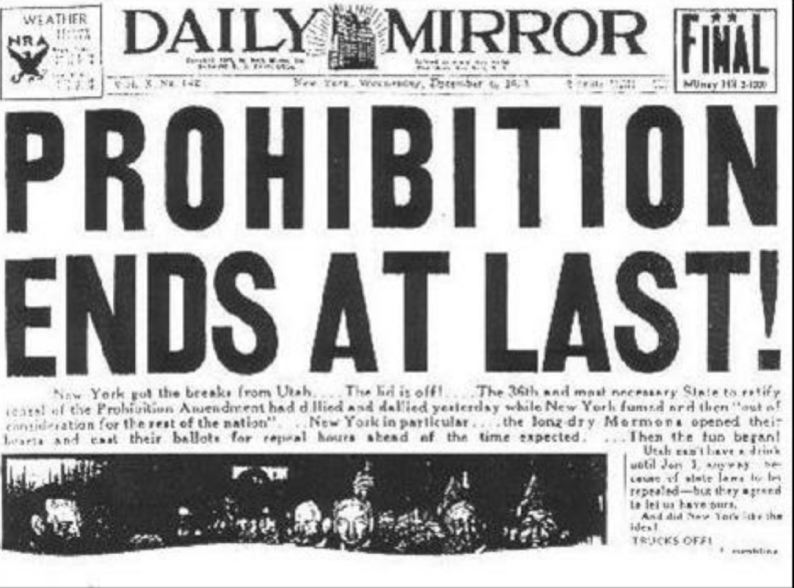 December 5, 2018, marked 85 years since the 18th Amendment of the U.S. Constitution was repealed, bringing an end to the prohibition of alcohol in the U.S. known as the “Noble Experiment.” The origins of Prohibition began in earnest with the formation of the Anti-Saloon League (ASL) in 1893. this organization was created specifically to end drinking in the U.S. and had a large following. California wine production was booming around this time, and by 1897 California wine production reached 34 million gallons Some of California’s legendary wineries such as Krug, Wente and Beringer were gaining success. At the ASL 20th annual conference in Columbus, Ohio, in 1913, the delegates voted unanimously to create a constitutional amendment that would prohibit the sale of alcohol in the U.S. The ASL was a well-organized lobbyist organization that linked drinking to the nation’s fear of venereal disease. In December of 1918, the Food Control Act was passed by Congress giving President Wilson the power to limit or prohibit the production of beer and wine if necessary to preserve resources for the war effort. About a year later, in January of 1919, the 18th Amendment of the Constitution of the U.S. became law marking the beginning of Prohibition. The 18th Amendment did not ban the consumption of alcohol, but prohibited the”manufacture, sale or transportation of intoxicating liquors.” You could drink all you wanted, but the means to obtain alcohol was illegal. A high demand for alcoholic beverages remained leading to widespread smuggling by rumrunners, moonshiners and bootleggers. Many illegal drinking establishments known as speakeasies became popular. Alcohol in various forms was sold throughout the U.S. at retail outlets. The U.S. was referred to as an “amphibian” nation since, in reality, it was neither dry nor wet. Although 80% of California wineries closed after the onset of Prohibition, significant wine production continued and the remaining wineries actually enjoyed a boom supplying sacramental wine, medicinal wine (physicians could prescribe alcohol for medicinal use), and concentrated grape juice for home winemakers. To combat the country’s continued appetite for alcohol, in October 1919, the Volstead Act, formerly known as the National War Prohibition Act was passed by Congress to provide enforcement of the Eighteenth Amendment. The problem was that there were many loopholes in the Act, and American wine consumption per capita increased while the Volstead Act was in effect.
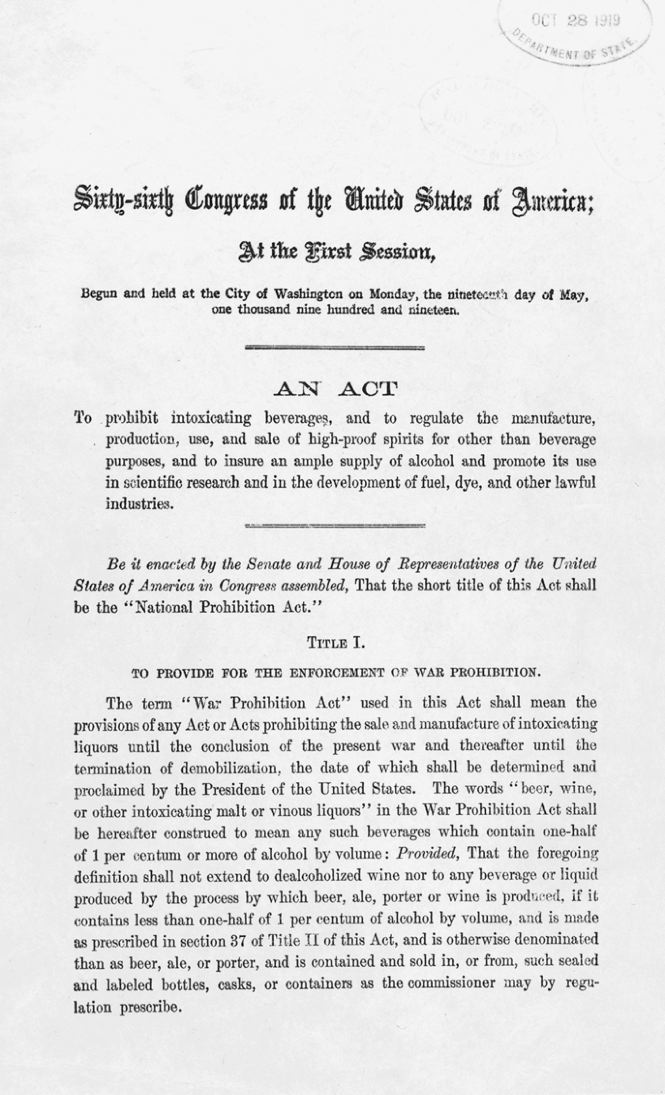 California grapevine acreage actually increased from 500,000 in 1919 to 650,000 by 1928, largely due to the widespread popularity of non-intoxicating concentrated fruit juices that were exempted by the Volstead Act. The California Vineyardist Association (CVA) was formed to produce and sell concentrated grape juice. Called VINE-GLO, this concentrated grape juice was available by mail order or through pharmacies. Nine varieties were available in kegs including “Burgundy.” The consumer was advised not to turn the juice into wine (“wink-wink”) but it was simply a matter of adding water to start fermentation and produce wine. In 1928, Herbert Hoover was elected President and he promised to intensify Prohibition enforcement. He would eventually admit that enforcement of Prohibition was futile. The repeal movement gathered momentum by businesses, organized labor and American women through the Woman’s Organization for National Prohibition Reform (WONPR). The WONPR had over a million members and opposed the oppression caused by enforcement. Ironically, it was the women’s temperance movement that was at the forefront of the push for Prohibition The repeal of Prohibition was a central issue in the 1932 presidential election. Franklin D. Roosevelt favored repeal, while Hoover wavered, and Roosevelt was elected. On December 6, 1932, Senator John J. Blaine of Wisconsin drafted the 21st Amendment that would nullify the 18th Amendment. The 21st Amendment was ratified in December 1933 by 35 states, with Utah finally agreeing to be the 36th state needed to write it officially into the Constitution on December 5 when Roosevelt signed the proclamation that ended Prohibition. .p> Prohibition lasted 13 years, 10 months and 18 days. This period was fifty-odd days less than the 14 years’ supply of wine laid down by the Yale Club in 1920. Prohibition is the only amendment to the Constitution to have ever been repealed.
* Largely excerpted from DRINK, A Cultural History of Alcohol, Iain Gately, Gotham Books, 2008. ߐ
Pinot BriefsOregon Researcher Looks to Increase Pinot Noir Yields Oregon State University researcher Patty Skinkis is in year seven of a ten-year research project to determine if Oregon growers of Pinot Noir can increase yields without reducing grape and wine quality. Typically, Oregon growers limit their crop to 2 to 2.5 tons per acre, but Skinkis believed they could crop significantly higher without lowering quality. She feels that the project has not reached the point of overcropping, and believes that a healthy Pinot Noir canopy in Oregon could support 5 tons. Joel Myers, viticulture manager for A to Z Wineworks and Ken Kupperman, vice president of Oregon farming for Jackson Family Wines have supported Skinkis’ work. Read the full report at: www.goodfruit.com/oregons-pinot-profusion/. Average Price of Oregon Pinot Noir Among the top 25 Oregon wineries, the average retail bottle price is $26.04 for Willamette Valley AVA Pinot Noir, but $14.30 for an Oregon appellation Pinot Noir. ‘Bay Area Revelations: America’s Wine Country’ TV Show Several California North Coast winemakers and winegrowers are featured in a new San Francisco Bay Area documentary. Set to air on December 8 and 23 on NBC Bay Area, the hourlong program will interview wine legends like Rolando Herrera, owner and winemaker of Mi Sueno Winery in Napa, Bo Barrett from Chateau Montelena, and the family behind Gundlach Bundshu. The program will also include vintners from outside the North Coast including Randall Grahm and Carolyn Wente. Latino Women in California Vineyards Over the past few years, women, and particularly Latina women, have increasingly joined vineyard crews. According to a research study, Changing Gender Diversity of the California Vineyard Labor Force and Implications for Grape Production conducted by UC Davis’ Cooperative Extension Program, Latina women in Napa Valley now make up almost 30% of vineyard workers. Between 2013 and 2016, the number of female seasonal vineyard workers increased by 24% in the Napa Valley. The authors believe that the gender diversity in the Napa Valley is equaled or even exceeded in other parts of California. Jason Lett, wine grape grower and winemaker of The Eyrie Vineyards, told me that “women have been crucial to the winery’s viticulture beginning with his mother.” He notes that two women are employed on their full-time vineyard crew of eight people. Normally Produced Wine is Gluten-Free Cheers for celiac disease sufferers, those that are gluten intolerant, Gerd sufferers and dieters. Gluten is a protein found in wheat, rye, barley and other grains. Obviously, beer is not gluten-free. Wine that is produced under normal circumstances is gluten-free. “Gluten-free” wine has to have less than 20 parts per million of gluten and the majority of wines are in compliance. Consumers should be aware that some types of wine with added color or flavoring or bottled wine coolers made with barley malt can have an unsafe amount of gluten. To be perfectly safe, celiac sufferers are advised to check the labels and/or consult with the winery. Cruise the Rhone River with Gary Farrell Vineyards & Winery Winemaker Theresa Heredia and General Manager Nancy Bailey will be hosting a winemaker dinner and educational seminars on this cruise through France’s legendary Rhône Valley wine region. The cruise from Lyon to Arles will be March 21-28, 2019. Staterooms start at $2,249 per person. For more information contact www.WineClub@CruiseShipCenters.com. Carl Giavanti Interview for Oregon Wine History Archives The Archive project at Linfield College includes oral history interviews with Oregon’s pioneering and contemporary winemakers as well as industry consultants. Carl talks about wine marketing and public relations and his view of the challenges facing wineries in the future. Visit https://oregonwinehistoryarchive.org/regions/oregon-wine-industry-businesses/carl-giavanti-collection/. Fourth Annual Willamette: The Pinot Noir Auction The nation’s top wine trade and media convene at The Allison Inn in Newberg, OR, for this event. Hosted by the Willamette Valley Wineries Association, the trade-only Auction will present its largest offering to date, with more than 85 lots of 2017 Pinot Noir. The Auction will also feature six collaborative Chardonnay lots. All lots are produced in quantities of 5, 10 or 20 cases, and will be exclusive to members of the wine trade attending the Auction. These wines are then made available to consumers by the winning bidders - restaurants and wine retailers. The 2018 Auction had a 48% increase in attendance over 2017, with registered bidders traveling from 23 states and 3 countries. The sale’s 81 lots generated a record-setting $737,000, exceeding the prior year’s Auction by 56%.
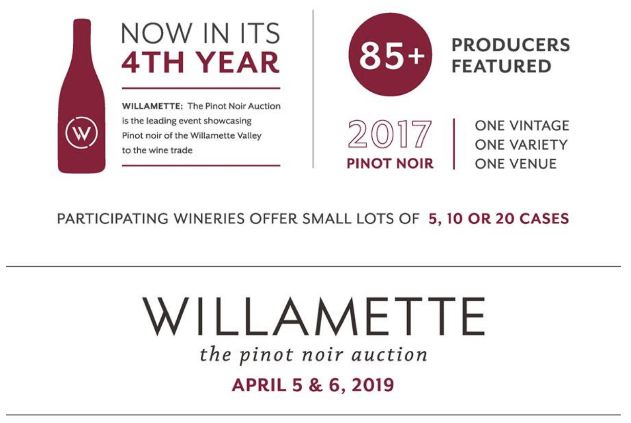 STACT Wine Displays, Inc. Offering Revolutionary Premium Wine Storage An all new patent design comprised of machined aircraft-grade aluminum offers a ready-to-install product that allows users to create their own unique wall design or incorporate the storage panels into a glass-enclosed wine cellar. Some of the glass-enclosed wine cellars pictured in the website gallery are incredible. View panel options, photos and pricing at www.getSTACT.com.
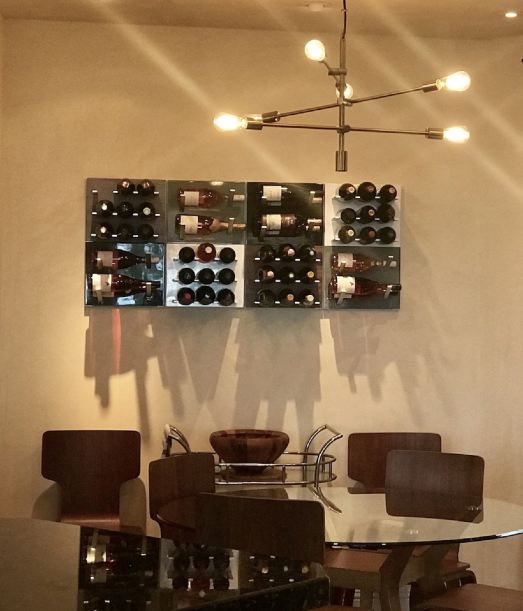 LEXUS Trunk Wine Cooler At the annual SEMA show in Las Vegas, LEXUS unveiled an ES 350 model with a fully functional wine cooler in the trunk compartment. Beyond storage for at least six bottles of wine, there is room for four wine glasses and a hiding fold-out table. The 16.7 cubic feet of trunk space still provides space for more cases of wine. The passenger compartment has floor mats made with wine corks and wine-themed stitching on the front headrests. The car’s engine does not run on Pinot Noir.
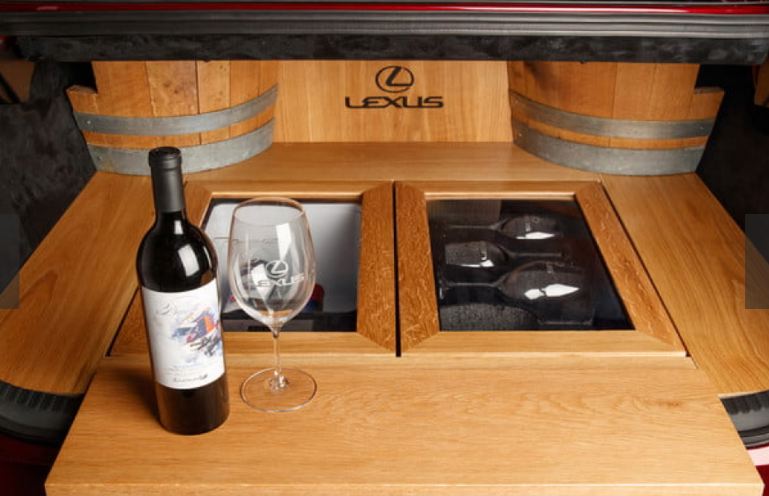
 Amateur Wine Researcher “Discovers” Nearly 400 Missing French Burgundy Vineyards Wine researcher Paul Messerschmidt found there are actually 1,628 climats. UNESCO documents had listed 1,247 vineyards (climats). The divergence was due to the fact that some climats share the same name with one or more climats. For example, there are vineyards called “Les Cras” in Chambolle- Musigny, Vougeot, Aloxe-Corton, Pommard and Meursault yet only one climat name is captured in UNESCO's count of 1,247 climats. Documentary “Harvest Season” Focuses on Latino Winemakers and Farmers Two-time Emmy nominated Mexican-American filmmaker Bernardo Ruiz produced the new documentary “Harvest Season,” showing the backstories of Latino wine producers and vineyard workers from multiple generations who have received little notoriety. The documentary focuses on winemaker Vanessa Robledo as well as acclaimed winemaker Gustavo Brambila. The film will premiere on PBS in the spring of 2019. New California AVAs on the Horizon The potential Alisos Canyon AVA is located in Santa Barbara County south of the Santa Maria Valley. Most of the vineyards are within 20 miles of the Pacific Ocean giving the area a significant marine influence. The are is known for Syrah and other Rhône wine grapes. The proposed Palos Verdes Peninsula covers 30,000 acres and is located in Los Angeles County. Residents here have been growing wine grapes for decades. There are at least two commercial vineyards. Along the coast, growers produce Pinot Noir and Chardonnay with warmer-weather varieties grown more inland. The proposed San Luis Obispo Coast AVA is wedged between Pismo Beach and Cambria. Vineyards here are between a quarter of a mile and 15 miles from the Pacific Ocean. Plantings of Pinot Noir, Syrah, Grenache and Albãrino are popular. The proposed West Sonoma Coast AVA lies within the existing Sonoma Coast AVA. Pinot Noir is grown here in an area considered to be on the edge of feasibility for successful production. Biggest Drinkers in the U.S. 24/7 Wall Street reviewed the 2017 expenditure data for metropolitan areas from the latest Consumer Expenditure Survey. The results showed that the biggest drinkers were in the West. The number one city in the U.S. was San Diego, California. The average San Diegan spent more on alcohol than anyone else in the U.S.: - $1,112. In comparison, the average amount a resident of San Diego spent on fruits and vegetables was $997. The rest of the top five behind San Diego in order were Seattle, Washington, San Francisco, California, Boston, Massachusetts and Anchorage, Alaska. The last city was Atlanta, Georgia with the average resident spending $385 annually. The full report is available at: www.usatoday.com/story/money/economy/2018/10/31/cities-that-spend-the-most-on-alcohol/38255755/.
Holiday Cheer May Be in Short Supply for North Coast Smaller Wineries
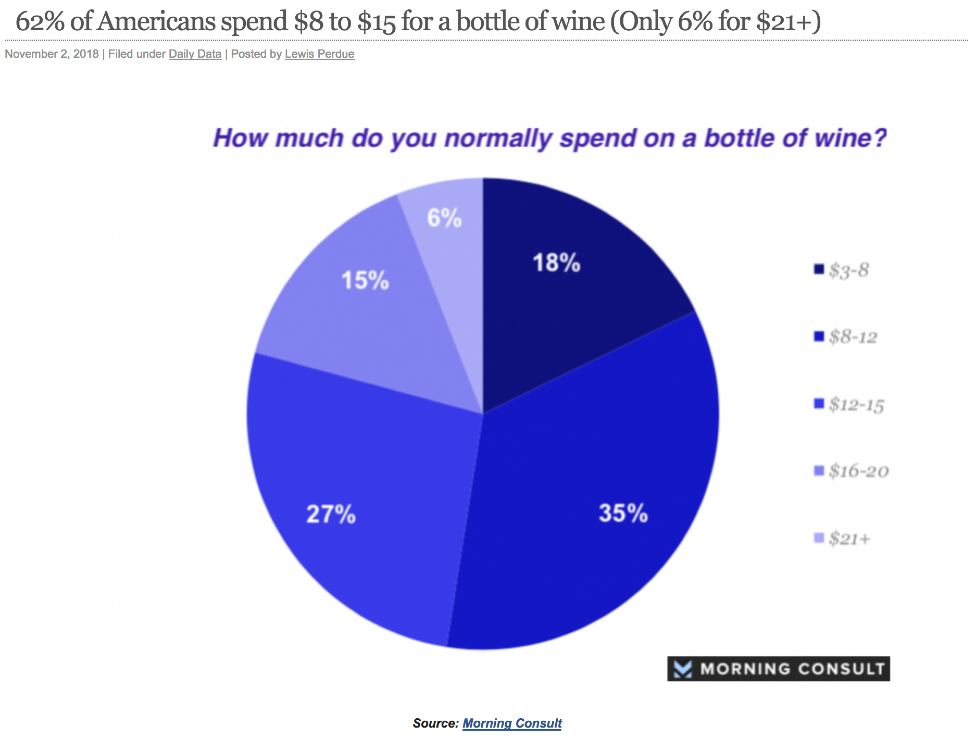 Recent reports from two seminars at the Wine Industry Network Expo in Santa Rosa paint a gloomy picture for Northern California’s small wineries. At least one wine business consultant and professional forecaster, Gabriel Froymovich has called the changing grape market cycle a “Grapepocalypse.” There is a myriad of reasons for the pessimism that include: (1) Slowdown in premium wine sales on the horizon. “Premiumization” is the aim for many small wineries as this class of expensive wines continues to grow. That said, there may not be enough consumers with deep pockets to support premium wine sales. The chart above indicates that only 6% of Americans spend $21 or above for wine; (2) Wine prices continue to rise; (3) Baby boomers are ageing and now spending less than Gen-Xers; (4) Visits to California wineries have decreased in wake of California’s wildfires and the tourist industry has not completely recovered. With so many wineries, there are fewer visitors per winery. Wineries cannot grow their direct sales without visitors to the tasting rooms; (5) Millenials want experiences at wineries and this adds significantly to overhead; (6) The impact of legalization of cannabis; (7) The “big guys” are taking over. The top two distributors in the U.S. handle 54 per cent of all wine sold. Large wine companies such as Constellation Brands are dominating the retail marketplace. Ten grocery chains control 50 per cent of the nationwide wine sales; (8) The North Coast harvest of 2018 was huge with a surplus of premium grapes and wine; (9) A looming recession. Many economic forecasters predict that there is a 95% chance a recession will occur within the next 5 years. A 7% drop in wine sales occurred in the year after the last 2008 recession. If a recession does occur, there will be a hiccup in wine retail sales, growers will experience shocks to their revenue streams and vineyard prices will be seriously affected; (10) The labor market is tightening and this could impact winery profitability. |